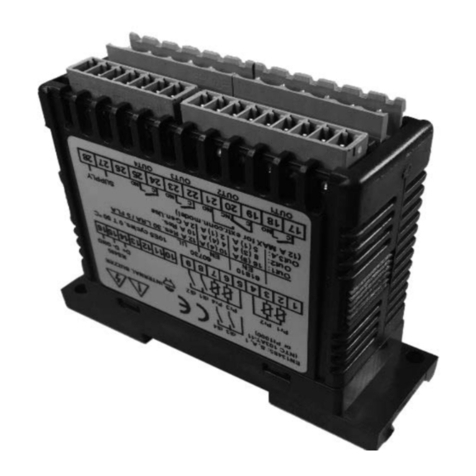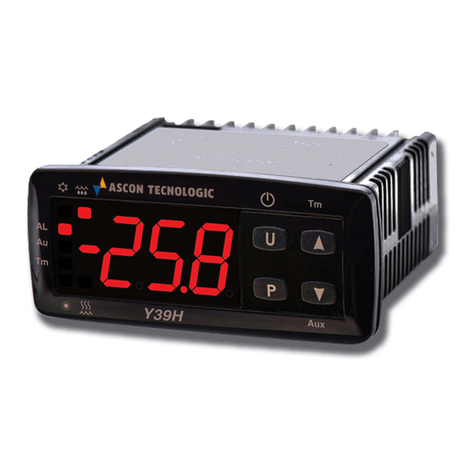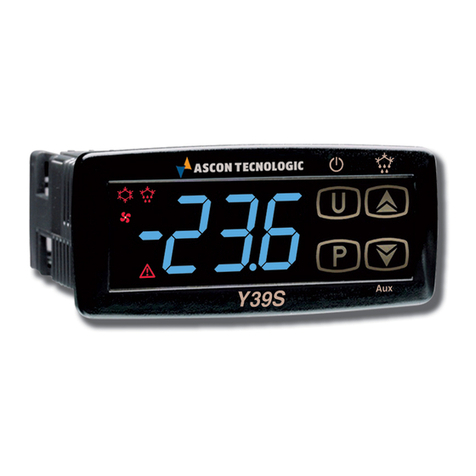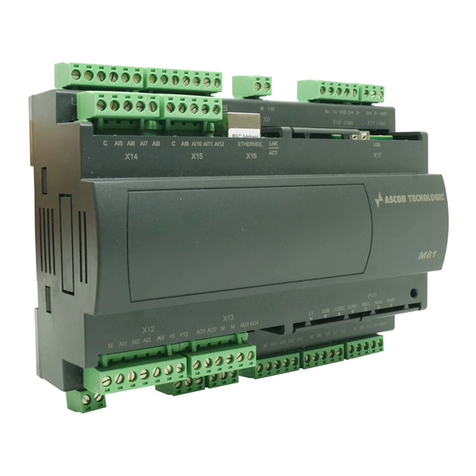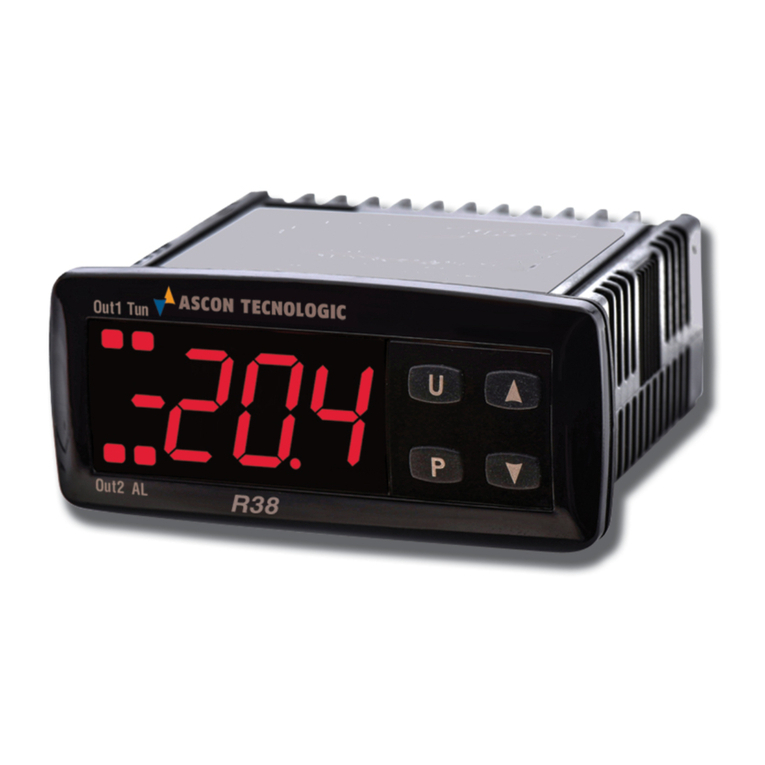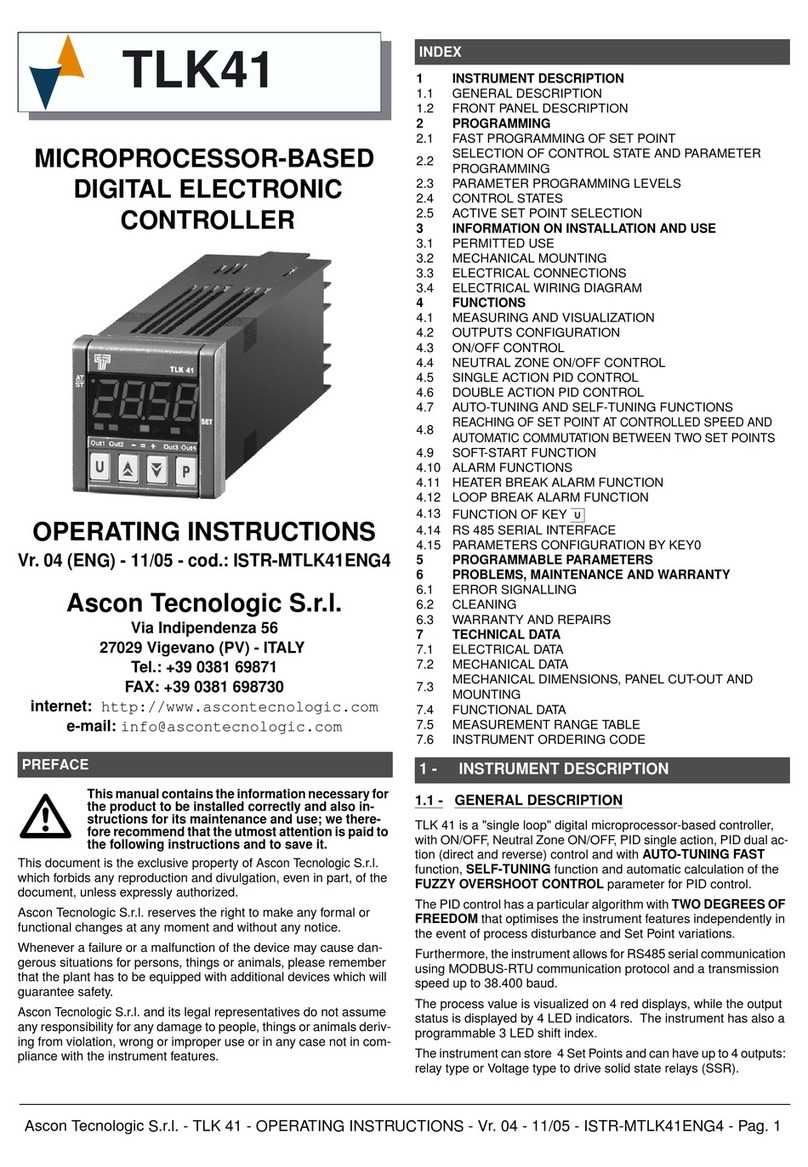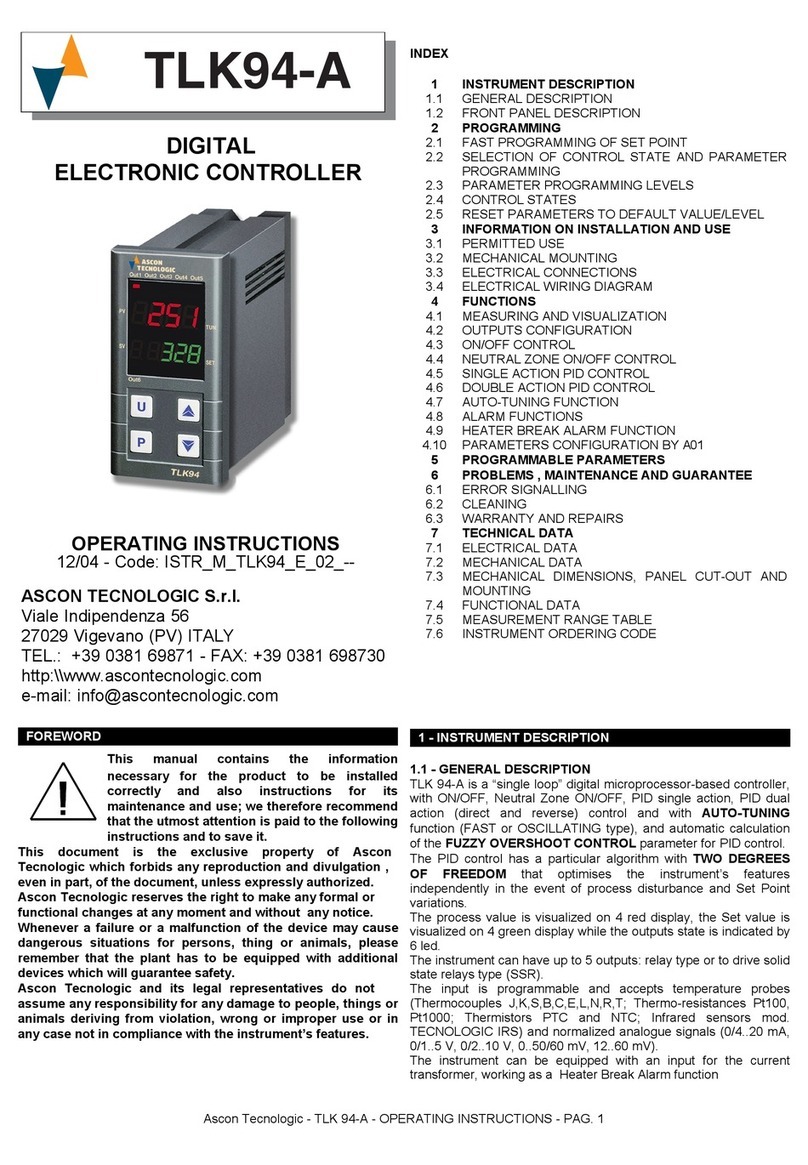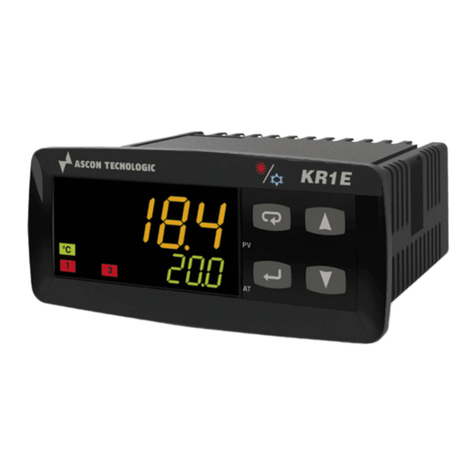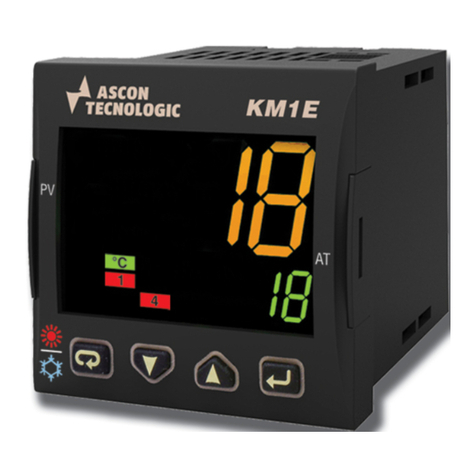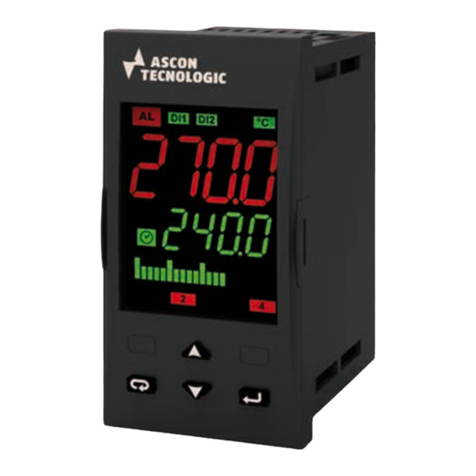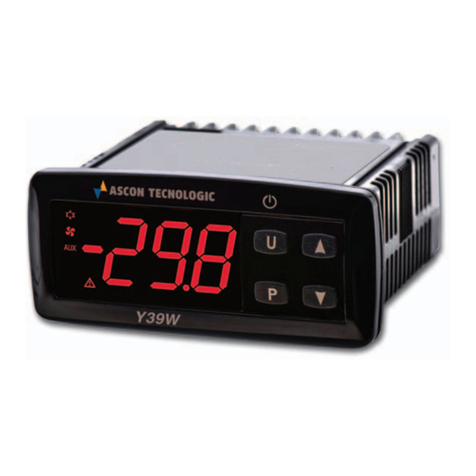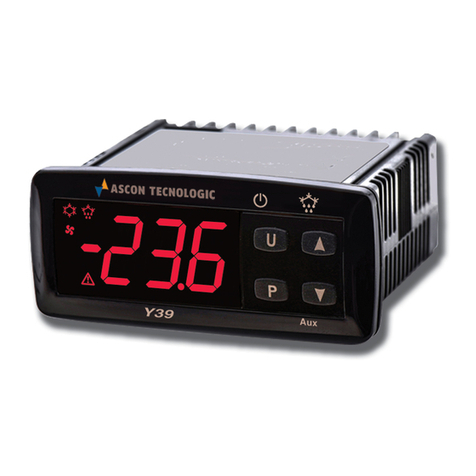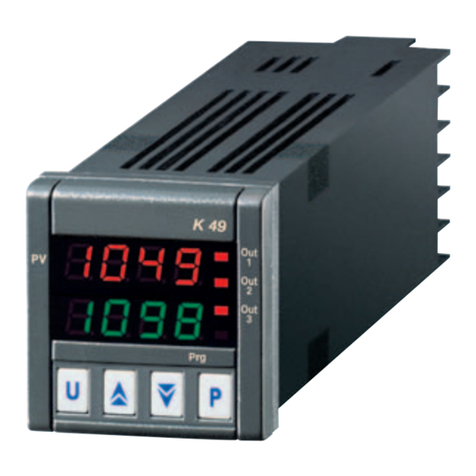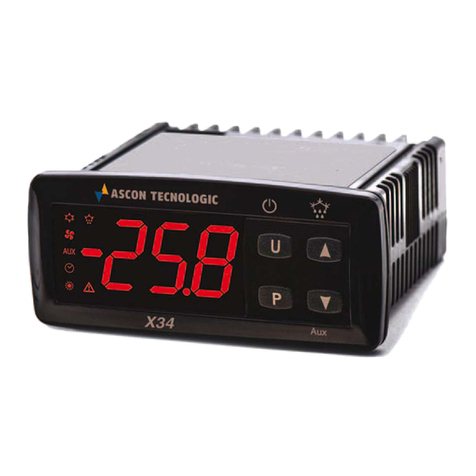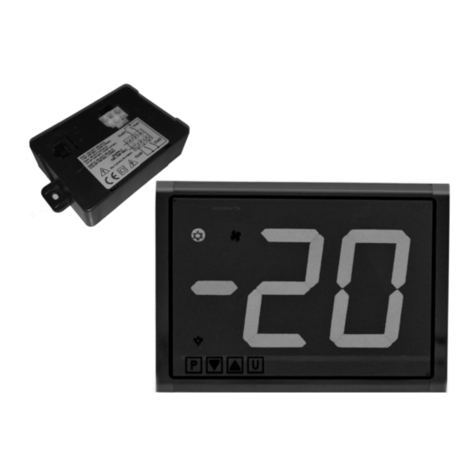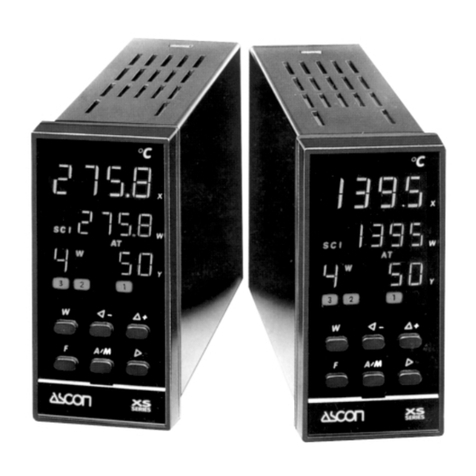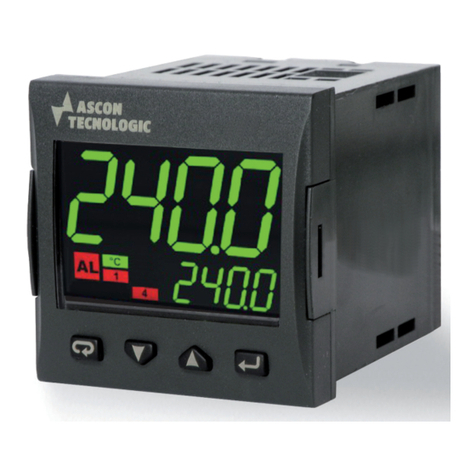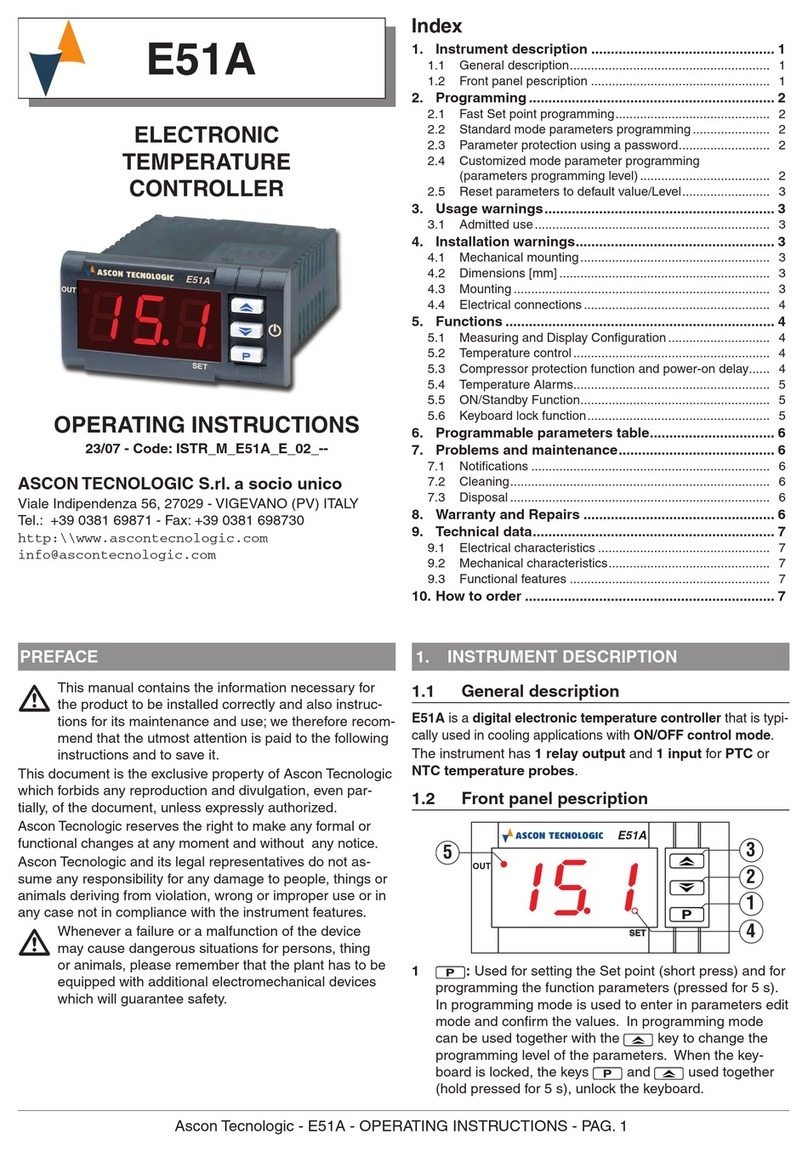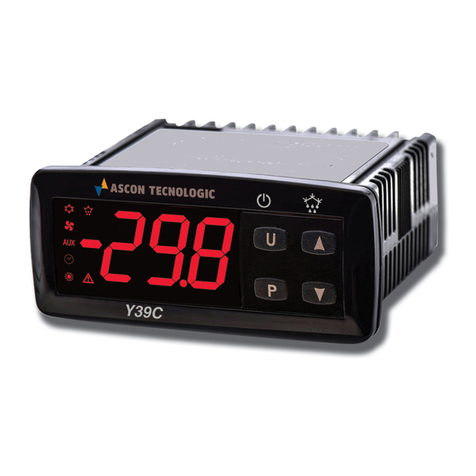At the same time as the si nallin of the confi ured alarm (buzzer
and/or output), the instrument si nals the alarm by turnin on the
led li ht AL, switchin off the LED OK, turnin on the led - in case
of minimum alarm or the led + for maximum alarm, and visualises
on the display:
- Alternately HI and the set variable in parameter “diSP” for
maximum alarm
- Alternately LO and the set variable in parameter “diSP” for the
minimum alarm
4.9.2 - EXTERNAL ALARM
The instrument can si nal an external alarm by activatin the di ital
input with the function pro rammed as “diF” = 4 or 9 (see par.
4.10).
At the same time as the si nallin of the confi ured alarm, the
instrument si nals the alarm by turnin on the led AL, turnin off
the led OK and visualisin AL and the variable set in parameter
“diSP” alternately on the display.
4.9.3 - OPEN DOOR ALARM
The instrument can si nal an open door alarm by activatin the
di ital input with the function pro rammed as “din” = 5 or 6 (see
par. 4.10).
When the di ital input is activated and after the delay pro rammed
in parameter “oAd” the instrument si nals the alarm via the
activation of the confi ured devices (buzzer and/or output), the
turnin on of the led AL, the turnin off of the led OK and AP and
the variable set in parameter “diSP” are visualised alternately on
the display.
4.9.4 - ALARM MEMORY
The instrument offers the possibility of arran in the alarm memory
function via the parameter “tAL”.
If "tAL" = no, the instrument cancels the alarm si nal when the
alarm status ends, if instead it is pro rammed as "yES" , the led AL
flashes even when the alarm status has ended to indicate that
there has been an alarm.
If the memorised alarm is for temperature, it also keeps the led -
flashin to show a minimum alarm and + to show a maximum
alarm.
To cancel the alarm memory si nal, press any key.
It must be remembered that if an output function is desired with an
alarm memory (=ALL or =-ALL) it is necessary to set the parameter
“tAL” = yES.
4.10 - DIGITAL INPUT
All the parameters concernin the di ital input functions are
contained in the roup “]din”.
The di ital input present on the instrument accepts contacts free of
volta e, the function carried out is defined by the parameter “diF”
and the action can be delayed for the time set in parameter “did”.
The parameter “diF” can be confi ured for the followin functions:
= 0 - Di ital input not active
= 1 - defrostin commencement command with contact normally
open: on closin the input (and after the “did” time) a defrostin
cycle is activated.
= 2 - defrostin end command with contact normally open: on
closin the input (and after the “did” time) a defrostin cycle is
ended if in pro ress or defrostin is inhibited.
= 3 - continuous cycle activation command with contact normally
open: on closin the input (and after the “did” time) a continuous
cycle is started up as described in the para raph on the continuous
cycle function.
= 4 - External alarm si nal with contact normally open: on closin
the input (and after the “did” time) the alarm is activated and the
instrument visualises AL and the variable set in parameter “diSP”
alternately on the display.
= 5 -Cell door openin with fan block with contact normally open:
on closin the input (and after the “did” time) the fans are stopped
and the instrument visualises AP and the variable set in parameter
“diSP” alternately on the display. With this function mode, the
action of the di ital input also activates the time that can be set in
parameter "oAd" after which the alarm is activated to si nal that the
door has been left open.
= 6 - Cell door openin with compressor and fan block with contact
normally open: similar to “diF” = 5 but with fan and compressor
block.
= 7 - Remote control of auxiliary output AUX with contact normally
open: on closin the input (and after the “did” time) the auxiliary
output is activated as described in the "FOA" = 2 function mode of
the auxiliary output.
= 8 - Selectin the active set point with contact normally open: on
closin the input (and after the “did” time) the temperature
re ulation set point “SP 2” is activated. When instead the input is
open the set point “SP 1” is active (see selectin active set point)
= 9 - Si nallin of external alarm with disablement of all the control
outputs with contact normally open: on closin the input (and after
the “did” time) all the control outputs are disabled, the alarm is
activated and the instrument visualises AL and the variable set in
parameter “diSP” alternately on the display.
= 10 - Switchin on/switchin off (Stand-by) of instrument with
contact normally open: on closin the input (and after the “did”
time) the instrument is switched on while it is placed in Stand-by
when opened.
= -1 - defrostin commencement command with contact normally
closed : similar to “diF”=1 but with function lo ic reversed.
= -2 - defrostin end command with contact normally closed :
similar to “diF”=2 but with function lo ic reversed.
= -3 - continuous cycle start-up command with contact normally
closed : similar to “diF”=3 but with function lo ic reversed.
= -4 - External alarm si nal with contact normally closed : similar to
“diF”=4 but with function lo ic reversed.
= -5 - Cell door openin with fan block with contact normally
closed : similar to “diF”=5 but with function lo ic reversed
= -6 - Cell door openin with compressor and fan block with contact
normally closed : similar to “diF”=6 but with function lo ic reversed.
= -7 - Remote control of auxiliary output AUX with contact normally
closed : similar to “diF”=7 but with function lo ic reversed.
= -8 - Selectin the active set point with contact normally closed :
similar to “diF”=8 but with function lo ic reversed.
= -9 - Si nallin of external alarm with disablement of all the
outputs with contact normally closed : similar to “diF”=9 but with
function lo ic reversed
= -10 - Switchin on/off (Stand-by) of instrument: similar to “diF”=10
but with function lo ic reversed.
4.11 - AUXILIARY OUTPUT
All the parameters concernin the auxiliary output functions are
contained in the roup “]AuS”.
The auxiliary outpurt can be confi ured to operate on any of the
outputs by pro rammin the parameter of the desired output =
AuS.
The function carried out is defined by the parameter “FOA” and the
function is conditioned by the time set in parameter “tuA”.
The parameter “FOA” can be confi ured for the followin functions:
= 0 - Auxiliary output not active
= 1 - Re ulation output delayed with contact normally open: the
auxiliary output is activated with delay that can be set on the
parameter "tuA" compared to the output confi ured as Out. The
output is then turned off at the same time as the OUT output is
disabled. This function mode can be used as a command for a
second compressor or for all other workin utilities accordin to the
same OUT output conditions, but which must be delayed after the
start-up of the compressor to avoid excess electricity absorption.
= 2 - Activation by front key (U or DOWN/AUX) or by di ital input
with contact normally open: the output is activated by pressin the
keys U or DOWN/AUX suitably confi ured (“USrb” or “Fbd” = 1) or
via activation of the di ital input if suitably confi ured (“diF”=7).
These commands have a bi-stable function, Which means that
when first pressed, the output key is activated while the second is
disabled. In this mode, the AUX output can be turned off
automatically after a certain time that can be set on the parameter
"tuA". With "tuA" = OFF the output is activated and deactivated only
manually, usin the front key (U or DOWN/AUX) or via the di ital
input. Differently, the output, once activated, is turned off
Ascon Tecnolo ic - TLY25 - OPERATING INSTRUCTIONS - PAG. 7
